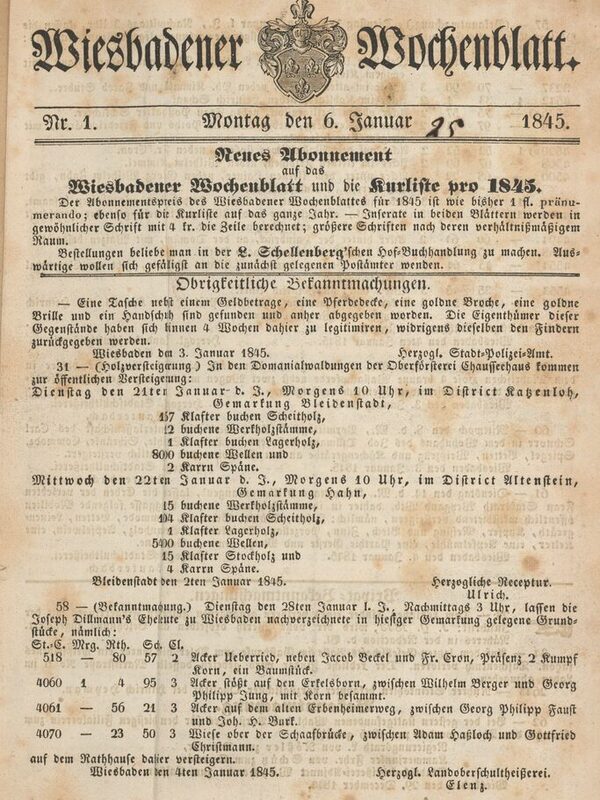Wiesbadener Wochenblatt
Under the unwieldy title "Hoch-Fürstlich Nassau-Saarbrück-Usingisch-privilegirte gemeinnützige Wießbader Nachrichten und Anzeige.", the Wiesbadener Wochenblatt was published from 1770 onwards in paperback format (16 x 20 cm) and with two to eight pages in the printing house of Johannes Schirmer.
Before the paper received its final name in 1806 with the title "Wiesbader Wochenblatt" (from 1837 "Wiesbadener Wochenblatt") and was published and printed by Heinrich Frey, it appeared for several years as "Gnädigst privilegirte Wiesbader Nachrichten zur Beförderung des Nahrungsstandes". Each issue published the most important food prices, announcements from the provincial government and other state agencies and information on auctions (e.g. of firewood). The registry office news was listed under the heading "Births, proclamations, marriages and deaths in the city of Wiesbaden". In the case of births, the parents were not named, only the father. If the mother's name appears, it was an illegitimate birth. Private real estate, job and capital market advertisements brought guilders into the printer's coffers. This was followed in winter by the list of "spa guests who had arrived" (published separately from 01.05. to 01.10.).
The 1809 edition of the Wiesbadener Wochenblatt was merged with the "Herzoglich-nassauischen allgemeinen Intelligenzblatt" and the "Verordnungsblatt des Herzogthums Nassau".
From 1824, the city awarded the Wiesbadener Wochenblatt every two years to the Wiesbaden printers, who had to pay a fee for the privilege. The economic upturn also benefited the Wiesbadener Wochenblatt. The number of subscribers rose from 118 copies (1784) to almost 900 (1837), and private advertisements in particular increased in volume. With a larger format (from 1808: 18 x 23 cm), the 1837 volume had reached 502 pages, in 1844 it was 594 pages. The city fathers finally auctioned off the privilege in favor of the city treasury.
The Schellenberg'sche Hofbuchdruckerei, whose turn it was to print the 1844 and 1845 volumes, did not adhere to the agreement made between the printers, significantly outbid the price agreement and received a ten-year contract for 1,000 fl. This sum was used for the planning costs and the sculptural work for the Hygieia group erected on the Kranzplatz in 1850. In 1852, two years before the contract expired, August Schellenberg developed the Wiesbadener Tagblatt from the Wiesbadener Wochenblatt. The Wiesbadener Wochenblatt continued to appear on a reduced scale until 1854.
Literature
Müller-Schellenberg, Guntram: Wiesbaden's press history, vol. 1: From Napoleon to Bismarck. The press in the field of tension between culture, economy and social conditions. Taunusstein 2011.
